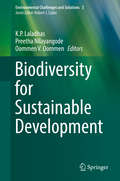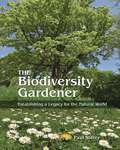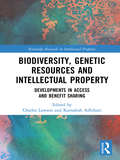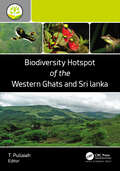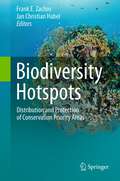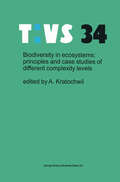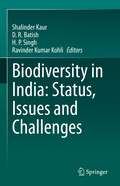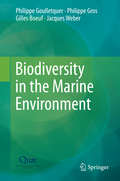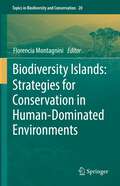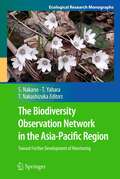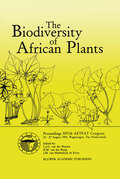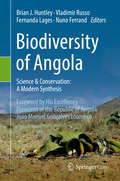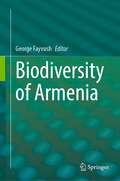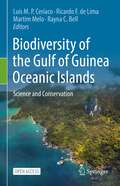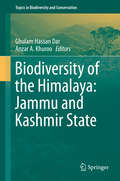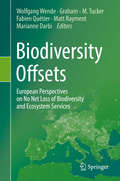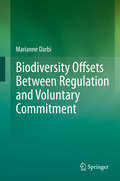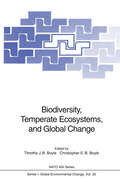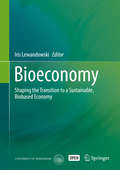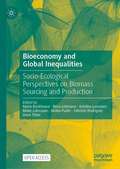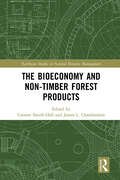- Table View
- List View
Biodiversity for Sustainable Development (Environmental Challenges and Solutions #3)
by K. P. Laladhas Preetha Nilayangode Oommen V. OommenDivided into three sections, this book explores the three main pillars of sustainable development, namely economy, environment and society, and their interlinkages at the regional level. The first section, Access and Benefit Sharing (ABS) for sustainable development, focuses on international agreements and national legislation, as well as the challenges in implementing ABS in e.g. India. In turn, the second section examines the process of forming Biodiversity Management Committees (BMCs) at the Local Self Government (LSG) level to promote environmental sustainability, highlighting local and community-level conservation initiatives that have led to the conservation of habitats and species. The third section addresses poverty eradication and food security. The case studies included demonstrate how the combination of traditional knowledge and modern techniques can enhance the productivity of traditional crop varieties, yielding greater benefits for communities. The aim of this volume is to disseminate the lessons learned from these case studies, as well as the findings from projects already in place, which can offer recommendations that can be applied to similar problems elsewhere in an attempt to find environmental solutions for sustainable development. Further, it introduces readers to new approaches to inclusive development, demonstrating that participation and grass root empowerment are key drivers of equitable and sustainable development.
The Biodiversity Gardener: Establishing a Legacy for the Natural World (Wild Nature Press #34)
by Paul SterryA personal account of—and guide to—unlocking the wildlife potential of gardens and other plots of land in lowland BritainOver the past decade, wildlife author and photographer Paul Sterry has nurtured, both through action and by doing nothing, what has become a small island of flourishing biodiversity in the half-acre garden that surrounds his north Hampshire cottage. By giving nature a free hand, and fostering habitats appropriate to this part of southeast England, he has enabled an abundance of native plant and animal species to call the garden home. This contrasts with the continued decline in biodiversity in the surrounding countryside. In this inspiring and informative book, Sterry tells the story of his own experiences in biodiversity gardening and offers detailed practical advice to anyone who wants to give nature the upper hand on their own bit of land, no matter how small.Hampshire still retains traces of its rich wildlife heritage, but changes in land use over the past half-century have had a devastating impact on local biodiversity. Against this backdrop, The Biodiversity Gardener presents a habitat-driven and evidence-based approach, describing how any gardener can unlock the wildlife potential of their plot and enjoy the satisfaction of watching it become home to a rich array of native species, including butterflies, wildflowers, grasshoppers, amphibians, and fungi.In The Biodiversity Gardener, Sterry explains the ecological imperative of adopting this approach. Collectively, biodiversity gardens could leave a lasting legacy—wildlife oases from which future generations stand a fighting chance of restoring Britain’s natural heritage. The book encourages and empowers readers to create their own biological inheritance for posterity—and shows them how they can do it.
Biodiversity, Genetic Resources and Intellectual Property: Developments in Access and Benefit Sharing (Routledge Research in Intellectual Property)
by Kamalesh Adhikari Charles LawsonDebates about Access and Benefit Sharing (ABS) have moved on in recent years. An initial focus on the legal obligations established by international agreements like the United Nations Convention on Biological Diversity and the form of obligations for collecting physical biological materials have now moved to a far more complex series of disputes and challenges about the ways ABS should be implemented and enforced: repatriation of resources, technology transfer, traditional knowledge and cultural expressions; open access to information and knowledge, naming conventions, farmers’ rights, new schemes for accessing pandemic viruses and sharing DNA sequences, and so on. Unfortunately, most of this debate is now crystallised into apparently intractable discussions such as implementing the certificates of origin, recognising traditional knowledge and traditional cultural expression as a form of intellectual property, and sovereignty for Indigenous peoples. Not everything in this new marketplace of ABS has been created de novo. Like most new entrants, ABS has disrupted existing legal and governance arrangements. This collection of chapters examines what is new, what has been changed, and what might be changed in response to the growing acceptance and prevalence of ABS of genetic resources. Biodiversity, Genetic Resources and Intellectual Property: Developments in Access and Benefit Sharing of Genetic Resources addresses current issues arising from recent developments in the enduring and topical debates about managing genetic resources through the ABS regime. The book explores key historical, doctrinal, and theoretical issues in the field, at the same time developing new ideas and perspectives around ABS. It shows the latest state of knowledge and will be of interest to researchers, academics, policymakers, and students in the fields of intellectual property, governance, biodiversity and conservation, sustainable development, and agriculture.
Biodiversity, Genetic Resources and Intellectual Property: Developments in Access and Benefit Sharing (Routledge Research in Intellectual Property)
by Charles Lawson Kamalesh AdhikariDebates about Access and Benefit Sharing (ABS) have moved on in recent years. An initial focus on the legal obligations established by international agreements like the United Nations Convention on Biological Diversity and the form of obligations for collecting physical biological materials have now moved to a far more complex series of disputes and challenges about the ways ABS should be implemented and enforced: repatriation of resources, technology transfer, traditional knowledge and cultural expressions; open access to information and knowledge, naming conventions, farmers’ rights, new schemes for accessing pandemic viruses and sharing DNA sequences, and so on. Unfortunately, most of this debate is now crystallised into apparently intractable discussions such as implementing the certificates of origin, recognising traditional knowledge and traditional cultural expression as a form of intellectual property, and sovereignty for Indigenous peoples. Not everything in this new marketplace of ABS has been created de novo. Like most new entrants, ABS has disrupted existing legal and governance arrangements. This collection of chapters examines what is new, what has been changed, and what might be changed in response to the growing acceptance and prevalence of ABS of genetic resources. Biodiversity, Genetic Resources and Intellectual Property: Developments in Access and Benefit Sharing of Genetic Resources addresses current issues arising from recent developments in the enduring and topical debates about managing genetic resources through the ABS regime. The book explores key historical, doctrinal, and theoretical issues in the field, at the same time developing new ideas and perspectives around ABS. It shows the latest state of knowledge and will be of interest to researchers, academics, policymakers, and students in the fields of intellectual property, governance, biodiversity and conservation, sustainable development, and agriculture.
Biodiversity Hotspot of the Western Ghats and Sri Lanka (Biodiversity Hotspots of the World)
by T. PullaiahBiodiversity is declining at an alarming rate due to anthropogenic activities around the world. This book is the first volume in the new series Biodiversity Hotspots of the World, which highlights the 36 hotspot regions of the world, regions that were designated as reaping maximum benefit from preservation efforts. This series is our humble attempt to document these hotspots as a conservation and preservation measure. This first volume in the series focuses on the Western Ghats and Sri Lanka, construed as forming a community of species because of their shared biogeographical history. The volume explores the diversity and conservation efforts of the extraordinarily rich species found here, including plants, many of which are found nowhere else in the world; forests, which face tremendous population pressure and have been dramatically impacted by demands for timber and agricultural land; as well as the hotspot’s diverse mammals, birds, insects, and amphibian species, and more. The volumes in this series will be essential resources for researchers and practitioners in the fields of conservation biology, ecology, and evolution.
Biodiversity Hotspot of the Western Ghats and Sri Lanka (Biodiversity Hotspots of the World)
by T. PullaiahBiodiversity is declining at an alarming rate due to anthropogenic activities around the world. This book is the first volume in the new series Biodiversity Hotspots of the World, which highlights the 36 hotspot regions of the world, regions that were designated as reaping maximum benefit from preservation efforts. This series is our humble attempt to document these hotspots as a conservation and preservation measure. This first volume in the series focuses on the Western Ghats and Sri Lanka, construed as forming a community of species because of their shared biogeographical history. The volume explores the diversity and conservation efforts of the extraordinarily rich species found here, including plants, many of which are found nowhere else in the world; forests, which face tremendous population pressure and have been dramatically impacted by demands for timber and agricultural land; as well as the hotspot’s diverse mammals, birds, insects, and amphibian species, and more. The volumes in this series will be essential resources for researchers and practitioners in the fields of conservation biology, ecology, and evolution.
Biodiversity Hotspots: Distribution and Protection of Conservation Priority Areas
by Frank E. Zachos and Jan Christian HabelBiodiversity and its conservation are among the main global topics in science and politics and perhaps the major challenge for the present and coming generations. This book written by international experts from different disciplines comprises general chapters on diversity and its measurement, human impacts on biodiversity hotspots on a global scale, human diversity itself and various geographic regions exhibiting high levels of diversity. The areas covered range from genetics and taxonomy to evolutionary biology, biogeography and the social sciences. In addition to the classic hotspots in the tropics, the book also highlights various other ecosystems harbouring unique species communities including coral reefs and the Southern Ocean. The approach taken considers, but is not limited to, the original hotspot definition sensu stricto and presents a chapter introducing the 35th hotspot, the forests of East Australia. While, due to a bias in data availability, the majority of contributions on particular taxa deal with vertebrates and plants, some also deal with the less-studied invertebrates. This book will be essential reading for anyone involved with biodiversity, particularly researchers and practitioners in the fields of conservation biology, ecology and evolution.
Biodiversity in ecosystems: principles and case studies of different complexity levels (Tasks for Vegetation Science #34)
by A. KratochwilThis volume does not aim at merely adding to the vast and increasing number of individual publications on `biodiversity'. Rather it is our objective to investigate biodiversity on the previously little studied coenosis and landscape levels. Phytosociological and animal-ecological fields are considered, as well as theoretical approaches to biodiversity and aspects of its application in nature and landscape protection and preservation. Since biodiversity has so far been predominantly studied in the Anglo-American area, it seemed to be of value to discuss this complex topic from a central and southern European viewpoint, based on data gathered in these regions, and thus to promote a global discussion.
Biodiversity in India: Status, Issues and Challenges
by Shalinder Kaur D. R. Batish H. P. Singh Ravinder Kumar KohliThis contributed book is based on the current status of biodiversity in India, issues and challenges faced by the authorities involved in conservation efforts, and the imperative role of various direct and indirect stakeholders in biodiversity conservation. The book discusses the current status of different forms of biodiversity in India, challenges faced by stakeholders, issues and reasons for biodiversity losses, and efforts by government through various laws, policies, and programs in a concise and comprehensive manner throughout its many chapters. In this way, readers can access diverse information on Indian biodiversity through this book. It is compiled by leading experts in the field of conservation. In 18 chapters, it covers biodiversity of both fauna and flora, on land and in aquatic ecosystems, legal and policy aspects, as well as innovative conservation tool and techniques. It is useful for undergraduates and graduate students and also educates policy planners, bureaucrats, foresters, and researchers in India and abroad.
Biodiversity in the Marine Environment
by Philippe Goulletquer Philippe Gros Gilles Boeuf Jacques WeberThe oceans cover over 70% of our planet. They are host to a biodiversity of tremendous wealth. Its preservation is now a global priority featuring in several international conventions and a confirmed objective of European policies and national strategies. Understanding the dynamics and the uses of the marine biodiversity is a genuine scientific challenge. Fourteen international experts have got together and identified five priority research themes to address the problem, based on analysing the state of knowledge.
Biodiversity Islands: Strategies for Conservation in Human-Dominated Environments (Topics in Biodiversity and Conservation #20)
by Florencia MontagniniThis book is intended to provide an overview for the identification and establishment of biodiversity islands. It presents examples and case studies where the biodiversity islands approach is being used in a variety of locations and contexts worldwide. It will contribute to design parameters on appropriate sizing and spatial distribution of biodiversity islands in order to be effective in conservation and regeneration across the landscape, using integrated landscape management approaches. This book is essential given the current worldwide trend of habitat destruction and the need to preserve biodiversity and its values. The chapters are organized in five sections. The first section provides the introduction. Section 2,3 and 4 discuss the challenges and alternatives of establishment and management, case studies across the globe, safeguarding of the environmental, economic, and social benefits, and the final section offers a conclusion. The contributing authors present views from the academic, the practitioner and the policymaker perspectives, offering alternatives and suggestions for promoting strategies that support biodiversity conservation through intentionally designed frameworks for sustainable forest landscapes. Readers will discover suggestions and concrete examples that can be used by a variety of stakeholders in various settings throughout the world. This book is useful to researchers, farmers, foresters, landowners, land managers, city planners, and policy makers alike.
The Biodiversity Observation Network in the Asia-Pacific Region: Toward Further Development of Monitoring (Ecological Research Monographs)
by Shin-ichi Nakano, Tetsukazu Yahara and Tohru NakashizukaBiological diversity is important for ecosystem function and services, which in turn is essential for human well-being. Under the Convention on Biological Diversity, international efforts have been made to achieve a significant reduction in the current rate of biodiversity loss. The loss continues, however. The Asia-Pacific region includes both developing countries with high biodiversity and developed countries with sophisticated data collection and analyses, but only limited information about the status quo of biodiversity in this region has been available. Many Asia-Pacific countries have rapidly grown their economies and social infrastructures, causing a loss of biodiversity and requiring an urgent mandate to achieve a balance between development and conservation in the region. In December 2009, scientists successfully organized the Asia-Pacific Biodiversity Observation Network in the region, to establish a network for research and monitoring of ecosystems and biodiversity and to build a cooperative framework. The present volume is the first collection of information on biodiversity in the Asia-Pacific and represents a quantum step forward in science that optimizes the synergy between development and biodiversity conservation.
The Biodiversity of African Plants: Proceedings XIVth AETFAT Congress 22–27 August 1994, Wageningen, The Netherlands
by Xander Van Der Maesen J. M. Van Medenbach De RooyProceedings of the XIVth AETFAT Congress, 22-27 August 1994, Wageningen, the Netherlands
Biodiversity of Angola: Science & Conservation: A Modern Synthesis
by Brian J. Huntley Vladimir Russo Fernanda Lages Nuno FerrandThis open access multi-authored book presents a 'state of the science' synthesis of knowledge on the biodiversity of Angola, based on sources in peer-reviewed journals, in books and where appropriate, unpublished official reports. The book identifies Angola as one of the most biologically diverse countries in Africa, but notes that its fauna, flora, habitats and the processes that drive the dynamics of its ecosystems are still very poorly researched and documented. This 'state of the science' synthesis is for the use of all students of Angola's biodiversity, and for those responsible for the planning, development and sustainable management of the country's living resources. The volume brings together the results of expeditions and research undertaken in Angola since the late eighteenth century, with emphasis on work conducted in the four decades since Angola's independence in 1975. The individual chapters have been written by leaders in their fields, and reviewed by peers familiar with the region.
Biodiversity of Armenia
by George FayvushArmenia is a small landlocked mountainous country located in the Southern Caucasus. It is a typical mountainous country, having its lowest point of 375m above sea level and culminating at 4095m with an average altitude of 1850m, where the landscapes and ecosystems form a complex multi-functional system. In general, the ecosystems of Armenia are characterized by a number of peculiarities, which all together contribute to formation of rich and unique biodiversity. On the small territory of Armenia (less than 30 thousand km2) there are about 3800 species of vascular plants (about a half of the whole Caucasian flora), 428 species of soil and water algae, 399 species of mosses, 4207 species of fungi, 464 species of lichens, 549 species of vertebrates and about 17200 species of invertebrates. The biodiversity of Armenia is notable for high endemism: about 500 species of fauna (about 3% of the fauna) and 147 species of flora (3.8% of total flora) are considered endemics. Such a high level of endemism is typical only for some of the large islands. Due to the huge variety of climates (from dry subtropics to cold alpine) and soil conditions all the main Caucasian ecosystems (besides humid subtropics) are represented in Armenia – deserts and semi-deserts, steppes, meadow-steppes, forests and open woodlands, sub-alpine and alpine vegetation as well as intrazonal ecosystems. Therefore Armenia is a biodiversity hotspot both within the Caucasian ecoregion and around the globe. This book compiles, summarizes and analyzes data on flora, fauna and mycobiota of Armenia, with a special focus on the impact of forecasted climate change on biodiversity and ecosystems of the region.
Biodiversity of the Gulf of Guinea Oceanic Islands: Science and Conservation
by Luis M. P. Ceríaco Ricardo F. de Lima Martim Melo Rayna C. BellThis open access book presents a comprehensive synthesis of the biodiversity of the oceanic islands of the Gulf of Guinea, a biodiversity hotspot off the west coast of Central Africa. Written by experts, the book compiles data from a plethora of sources – archives, museums, bibliography, official reports and previously unpublished data – to provide readers with the most updated information about the biological richness of these islands and the conservation issues they face. The Gulf of Guinea Oceanic Islands (Príncipe, São Tomé and Annobón and surrounding islets) present extraordinary levels of endemism across different animal, fungi and plant groups. This very high endemism likely results from the long geological history of the islands and their proximity to the diversity-rich continent. Many researchers, students and conservationists from across the globe are interested in documenting biodiversity on the islands, understanding the evolutionary origins of this diversity, and mitigating the impacts of global change on this unique archipelago. This book aims to be a primer for a broad audience seeking baseline biodiversity information and to serve as a roadmap for future research efforts aiming to fill knowledge gaps in understanding and conserving the unparalleled biodiversity of the Gulf of Guinea islands.
Biodiversity of the Himalaya: Jammu and Kashmir State (Topics in Biodiversity and Conservation #18)
by Ghulam Hassan Dar Anzar A. KhurooThe Himalaya, a global biodiversity hotspot, sustains about one-fifth of the humankind. Nestled within the north-western mountain ranges of the Himalaya, the Jammu and Kashmir (J&K) State harbours more than half of the biodiversity found in the Indian Himalaya. The wide expanse of State, spread across the subtropical Jammu, through the temperate Kashmir valley, to the cold arid Ladakh, is typical representative of the extensive elevational and topographical diversity encountered in the entire Himalaya.This book, the most comprehensive and updated synthesis ever made available on biodiversity of the J&K State, is a valuable addition to the biodiversity literature with global and regional relevance. The book, arranged into 7 parts, comprises of 42 chapters contributed by 87 researchers, each of whom is an expert in his/her own field of research. The precious baseline data contained in the book would form the foundation for assessing current status of knowledge about the bioresources, identify the knowledge gaps, and help prioritization of conservation strategies to steer the sustainable use of biodiversity in this Himalayan region. Given the breadth of topics covered under the banner of biodiversity in this book, it can surely serve as a model for documentation of biodiversity in other regions of the world. The book will be of immense value to all those who, directly or indirectly, have to deal with biodiversity, including students, teachers, researchers, naturalists, environmentalists, resource managers, planners, government agencies, NGOs and the general public at large.
Biodiversity Offsets: European Perspectives on No Net Loss of Biodiversity and Ecosystem Services
by Wolfgang Wende Graham Tucker Fabien Quétier Matt Rayment Marianne DarbiThis book deals with the new concept of biodiversity offsets. The aim of offsetting schemes is to achieve no let loss or even net gain of biodiversity. Offsets obey a mitigation hierarchy and reflect the precautionary and polluter-pays principle in regard to project impacts. Readers gain insights into current debates on biodiversity policies, with top experts outlining theoretical principles and the latest research findings. At the same time the focus is on practical application and case studies. Today there is a lively international discussion among practitioners and scientists on the optimal legal framework, metrics and design of habitat banks to ensure the success of biodiversity offsets and to minimise the risks of failure or misuse. Contributing to the debate, this volume presents the activities and practices of biodiversity offsetting already implemented in Europe in selected EU member states, and the lessons that can be learnt from them. Readers may be surprised at how much experience already exists in these countries. A further aim of the book is to offer grounded insights on the road ahead, and foster a more intensive and fruitful discussion on how offsetting can be extended and improved upon, so that it becomes a key and effective component of Europe’s biodiversity conservation policy framework.
Biodiversity Offsets Between Regulation and Voluntary Commitment: A Typology of Approaches Towards Environmental Compensation and No Net Loss of Biodiversity
by Marianne DarbiWe are witnessing an alarming, global biodiversity crisis with an ongoing loss of species and their habitats. In response, a number of tools and approaches – including some that are contested – are being explored and promoted. Biodiversity offsets are one such approach, and deserve critical examination since the debate surrounding them has often been oversimplified and lacking practical evidence. As such, this study presents a refined typology including seven types of biodiversity offsets and taking into account different contexts, governance arrangements and drivers. It draws on a detailed analysis of theoretical concepts to explain the voluntary implementation of biodiversity offsets using an internet-based (netnographic) research approach. Furthermore it builds on a broad global explorative base of 72 practical examples and presents in-depth case studies for each type. The results reveal a number of global tendencies that allow recommendations to be made for different locations, contexts and stakeholders. They also encourage the expansion of this research field to respond to the pressing needs of policy and practice.
Biodiversity, Temperate Ecosystems, and Global Change (Nato ASI Subseries I: #20)
by Timothy J. B. Boyle Christopher E. B. BoyleReviewed here is the current state of knowledge concerning the relationship between global change and biodiversity of temperate ecosystems. The aim is to improve the ability to conserve biodiversity under conditions of global change.The book focuses on:- The threats posed by global change to biodiversity in temperate ecosystems; - Levels and spatial patterns of diversity in temperate ecosystems; - The impact of global change on genetic diversity; - The effects of disturbance (natural and anthropogenic) on temperate ecosystems; - Existing research priorities and programmes.
Bioeconomic Modelling and Valuation of Exploited Marine Ecosystems (Economy & Environment #28)
by J.C.J.M. van Bergh J. Hoekstra R. Imeson P.A.L.D. Nunes A.T. de BlaeijThis book offers an environmental-economic analysis of exploited ecosystems with a clear policy orientation. The study moves beyond traditional economic fishery analysis in two respects. First, several theoretical and numerical models are offered that combine economic and ecological descriptions of fisheries. Second, valuation and stakeholder concerns are addressed in empirical analyses employing both qualitative and quantitative approaches. The approaches, models and policy insights are sufficiently general and innovative to interest a broad audience.
Bioeconomy: Shaping the Transition to a Sustainable, Biobased Economy (Economic Complexity And Evolution Ser.)
by Iris LewandowskiThis book is open access under a CC BY 4.0 license.This book defines the new field of "Bioeconomy" as the sustainable and innovative use of biomass and biological knowledge to provide food, feed, industrial products, bioenergy and ecological services. The chapters highlight the importance of bioeconomy-related concepts in public, scientific, and political discourse. Using an interdisciplinary approach, the authors outline the dimensions of the bioeconomy as a means of achieving sustainability.The authors are ideally situated to elaborate on the diverse aspects of the bioeconomy. They have acquired in-depth experience of interdisciplinary research through the university’s focus on “Bioeconomy”, its contribution to the Bioeconomy Research Program of the federal state of Baden-Württemberg, and its participation in the German Bioeconomy Council.With the number of bioeconomy-related projects at European universities rising, this book will provide graduate students and researchers with background information on the bioeconomy. It will familiarize scientific readers with bioeconomy-related terms and give scientific background for economists, agronomists and natural scientists alike.
Bioeconomy and Global Inequalities: Socio-Ecological Perspectives on Biomass Sourcing and Production
by Maria Backhouse Rosa Lehmann Kristina Lorenzen Malte Lühmann Janina Puder Fabricio Rodríguez Anne TittorThis open access book focuses on the meanings, agendas, as well as the local and global implications of bioeconomy and bioenergy policies in and across South America, Asia and Europe. It explores how a transition away from a fossil and towards a bio-based economic order alters, reinforces and challenges socio-ecological inequalities. The volume presents a historically informed and empirically rich discussion of bioeconomy developments with a particular focus on bio-based energy. A series of conceptual discussions and case studies with a multidisciplinary background in the social sciences illuminate how the deployment of biomass sources from the agricultural and forestry sectors affect societal changes concerning knowledge production, land and labour relations, political participation and international trade. How can a global perspective on socio-ecological inequalities contribute to a complex and critical understanding of bioeconomy? Who participates in the negotiation of specific bioeconomy policies and who does not? Who determines the agenda? To what extent does the bioeconomy affect existing socio-ecological inequalities in rural areas? What are the implications of the bioeconomy for existing relations of extraction and inequalities across regions? The volume is an invitation to reflect upon these questions and more, at a time when the need for an ecological and socially just transition away from a carbon intensive economy is becoming increasingly pressing.
The bioeconomy and non-timber forest products (Earthscan Studies in Natural Resource Management)
by Carsten Smith-Hall James ChamberlainThis book provides the first in-depth investigation of how non-timber forest products are an integral part of local, national, and global bioeconomies. While the plants and fungi that produce non-timber forest products are essential to the sustainability of forest ecosystems, peoples' food and livelihood security and sovereignty, and thus the bioeconomy, are often absent from bioeconomic strategies. Presenting a selection of empirical cases from around the world that engage with the bioeconomy and non-timber forest products, this volume reveals how essential these products are to creating a greener and more sustainable future, how to to better integrate them into efforts to transition to and expand the bioeconomy, and how such efforts can be supported and developed. Chapters analyse how and to what degree non-timber forest products promote sustainable resource use, generate employment, and contribute to food and livelihood security and poverty alleviation. The volume develops approaches and identifies interventions and policies to support the integration of non-timber forest products into bioeconomy strategies, including in national reporting schemes to provide recommendations for future research and practical implementation. This book will be of great interest to students and scholars of forest and natural resource management, bioeconomics, circular economy and ecological economics more widely. It will also be of interest to professionals working in sustainable development and the forestry sector.
The bioeconomy and non-timber forest products (Earthscan Studies in Natural Resource Management)
by Carsten Smith-Hall James L. ChamberlainThis book provides the first in-depth investigation of how non-timber forest products are an integral part of local, national, and global bioeconomies. While the plants and fungi that produce non-timber forest products are essential to the sustainability of forest ecosystems, peoples' food and livelihood security and sovereignty, and thus the bioeconomy, are often absent from bioeconomic strategies. Presenting a selection of empirical cases from around the world that engage with the bioeconomy and non-timber forest products, this volume reveals how essential these products are to creating a greener and more sustainable future, how to to better integrate them into efforts to transition to and expand the bioeconomy, and how such efforts can be supported and developed. Chapters analyse how and to what degree non-timber forest products promote sustainable resource use, generate employment, and contribute to food and livelihood security and poverty alleviation. The volume develops approaches and identifies interventions and policies to support the integration of non-timber forest products into bioeconomy strategies, including in national reporting schemes to provide recommendations for future research and practical implementation. This book will be of great interest to students and scholars of forest and natural resource management, bioeconomics, circular economy and ecological economics more widely. It will also be of interest to professionals working in sustainable development and the forestry sector.
